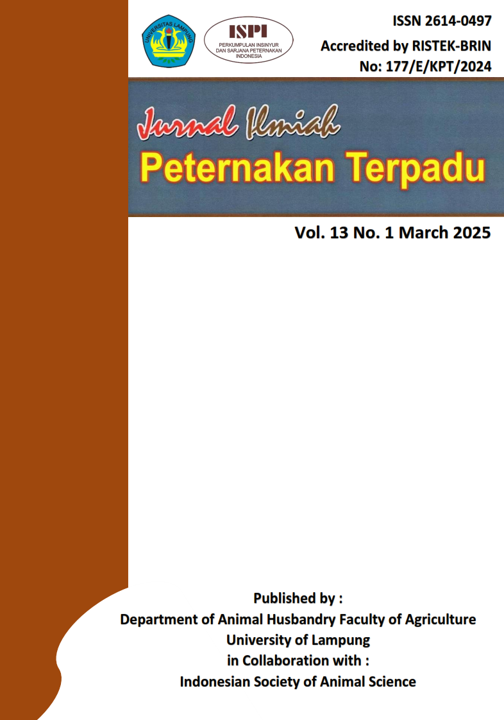Utilization of Milk Waste as a Probiotic in Drinking Water for Performance Improvement and Income Over Feed Cost of Broiler Chickens
DOI:
https://doi.org/10.23960/jipt.v13i1.p43-60 Abstract View: 381
Abstract View: 381
Keywords:
Broiler Chickens, IOFC, Performance, Prebiotic, ProbioticAbstract
The increasing demand for chicken meat consumption every year drives farmers to optimize the production performance of broiler chickens. The administration of probiotics has become one solution to maximize production. Probiotics are live microorganisms that enhance digestive efficiency. Prebiotics from milk waste and kefir grain starter are used as media for probiotic production, containing bacteria such as Lactobacillus, Bacillus sp., Pediococcus, Streptococcus, and Saccharomyces. This study aims to evaluate the effectiveness of performance and income over feed cost (IOFC) from probiotic supplementation during the finisher phase of broiler chickens. The research method uses a Completely Randomized Design (CRD) with four treatments and five replications: P0 (without probiotics), P1 (3% probiotics), P2 (5% probiotics), and P3 (7% probiotics). Probiotics were administered in the broilers' drinking water from evening until morning. Statistical testing employed One Way ANOVA and Duncan's multiple range test. The results showed that the best probiotic dose was P3 (7% probiotics), with 0% mortality, an average feed consumption of 152 g/bird/day, final body weight of 2203 g/bird, average daily weight gain of 257 g/bird, an average Feed Conversion Ratio (FCR) of 1.467, and an excellent Performance Index (PI) of 354 (>351-400). The 7% probiotic dose in drinking water provided the highest IOFC, amounting to Rp. 10,263 per bird.Downloads
References
Ahmad, I. 2006. Effect of probiotics on broilers performance. Int. J. Poul. Sci., 5(6), 593- 597.
Ali, N., Agustina, A., Dahniar, D. 2019. Pemberian Dedak yang Difermentasi Dengan EM4 Sebagai Pakan Ayam Broiler. Agrovital. Jurnal Ilmu Pertanian. 4(1), 1. https://doi.org/10.35329/agrovital.v4i1.298.
Astuti, F. K., Busono, W., & Sjofjan, O. 2015. Pengaruh Penambahan Probiotik Cair Dalam Pakan Terhadap Penampilan Produksi Pada Ayam Pedaging. J-PAL, 6(2).
Bensmira, M., Nsabimana, C., Jiang, B. 2010. Effects Of Fermentation Conditions and Homogenization Pressure on the Rheological Properties Of Kefir. Food Sci. Tech. 43, 1180-1184
[BPS]. Badan Pusat Statistik . 2022. Populasi Ayam Ras Pedaging. Jakarta (ID): BPS. [Online]. Tersedia pada : https://www.bps.go.id/id/statistics-table/2/NDc4IzI=/populasi-ayam-ras-pedaging-menurut-provinsi--ekor-.html
[BPS]. Badan Pusat Statistik . 2023. Produksi Daging Ayam Ras Pedaging. Jakarta (ID): BPS. [Online]. Tersedia pada : https://www.bps.go.id/id/statistics-table/2/NDg4IzI=/produksi-daging-ayam-ras-pedaging-menurut-provinsi.html
Dehgani, B., dan Nahashon, S.N. 2014. A Review On Effects Of Aloe Vera as a Feed Additive In Broiler Chicken Diets. Ann. Anim. Sci., 14, 491–500.
Dittoe, D.K., Rickie, S.C., Kiess A.S. 2018. Organic Acids and Potentia for Modifying the Avian Gastrointestinal Tract and Reducing Pathogens and Disease. Frontiers in Veterinary Science. 5(1),1-12.
Fanani, F, A., Fajrih, N. H., Meilia Anjani, F., Hadziq Qulubi, M. 2023. Performa Ayam Broiler dengan Penambahan Kefir Sebagai Probiotik Performance of Broiler With the Addition of Kefir as a Probiotic. Jurnal Galung Tropika. 12(1), 25–34. https://doi.org/10.31850/jgt.v12i1.1012
Farid Ariakusuma. 2019. Stress Pada Ayam dan Solusinya. Farmsco. Ayam dan Solusinya. Farmsco. https://www.farmsco.co.id/jurnal/stress-pada-ayam-dan-solusinya.
Gaps I, Siti, N., & AAPP Wibawa, dan. 2020. Pengaruh Pemberian Probiotik Melalui Air Minum Terhadap Karakteristik Karkas Itik Bali Betina Yang Diberi Ransum Mengandung Limbah Kulit Kecambah Kacang Hijau. Jurnal Peternakan Tropika, 8(3) , 639–651. https://doi.org/10.24843/JPT
Isolauri, E., Salmien S., 2009. The Imapct of Probiotic on gut health. Curr Drug Metab. 10(1);68-78.
Kartasudjana, R dan E. Suprijatna. 2010. Manajemen Ternak Unggas. Penebar Swadaya, Jakarta. 81-94.
Downloads
Published
How to Cite
Issue
Section
License

Jurnal Ilmiah Peternakan Terpadu(JIPT) is licensed under a Creative Commons Attribution 4.0 International License.
Authors who publish with this journal agree to the following terms:
- Authors retain copyright and grant the journal right of first publication with the work simultaneously licensed under a Creative Commons Attribution License that allows others to share the work with an acknowledgement of the work's authorship and initial publication in this journal.
- Authors are able to enter into separate, additional contractual arrangements for the non-exclusive distribution of the journal's published version of the work (e.g., post it to an institutional repository or publish it in a book), with an acknowledgement of its initial publication in this journal.
- Authors are permitted and encouraged to post their work online (e.g., in institutional repositories or on their website) prior to and during the submission process, as it can lead to productive exchanges, as well as earlier and greater citation of published work (See The Effect of Open Access).





















